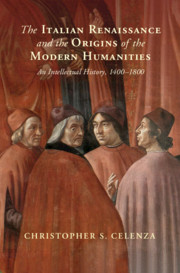Book contents
- The Italian Renaissance and the Origins of the Modern Humanities
- The Italian Renaissance and the Origins of the Modern Humanities
- Copyright page
- Dedication
- Contents
- Figures
- Preface and Acknowledgments
- 1 Philology, the Italian Renaissance, and Authorship
- 2 Lorenzo Valla, Philology, Emotion
- 3 Losing Your Identity: Angelo Decembrio
- 4 Trust and Authenticity
- 5 Pursuing a Love of Knowledge
- 6 Shaping Knowledge
- 7 Forgetting Philology: René Descartes
- 8 Certainty. Skepticism
- 9 Echoes
- Bibliography
- Index
1 - Philology, the Italian Renaissance, and Authorship
Published online by Cambridge University Press: 09 November 2021
- The Italian Renaissance and the Origins of the Modern Humanities
- The Italian Renaissance and the Origins of the Modern Humanities
- Copyright page
- Dedication
- Contents
- Figures
- Preface and Acknowledgments
- 1 Philology, the Italian Renaissance, and Authorship
- 2 Lorenzo Valla, Philology, Emotion
- 3 Losing Your Identity: Angelo Decembrio
- 4 Trust and Authenticity
- 5 Pursuing a Love of Knowledge
- 6 Shaping Knowledge
- 7 Forgetting Philology: René Descartes
- 8 Certainty. Skepticism
- 9 Echoes
- Bibliography
- Index
Summary
This chapter introduces readers to philology, defined as “making sense of texts,” and argues that it is a good way to view how certain thinkers in the Italian Renaissance read, interpreted, and worked their way through texts. It introduces the main themes of the book: that the available technologies of reading and writing – whether these are quills and animal skins or screens and the cloud – have great impact on what thinkers conceive as possible when it comes to their work; that authorship can be conceived as collective; that the use of the Latin language by Renaissance thinkers opened up meaningful possibilities even as it circumscribed their thinking within limits they did not always recognize; and that, especially for Renaissance thinkers, philosophy – defined as the search for wise way of life – and philology were inextricably linked. This chapter also suggests that recent work on history of women in the Renaissance – especially on women’s authorship – opens up new windows onto the intellectual history of the period. Finally, this chapter sets out one of this book’s guiding principles: to relate the episodes under consideration to problems in the humanities that have relevance today.
Keywords
- Type
- Chapter
- Information
- The Italian Renaissance and the Origins of the Modern HumanitiesAn Intellectual History, 1400–1800, pp. 1 - 19Publisher: Cambridge University PressPrint publication year: 2021

